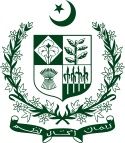Democracy in Pakistan
 |
|---|
|
|
Democracy (Template:Lang-ur; pronounced jamhooriat) is one of the ideologies and systems upon which Pakistan was sought to be established in 1947 as a nation-state, as envisaged by the leader and founding father of the nation, Muhammad Ali Jinnah. Pakistan constitutionally is a democratic parliamentary republic with its political system based on an elected form of governance. However, in past history there have been deviations from democracy in the form of military coups and political uncertainty.[1] As of current status, Pakistan is also the largest non-liberal democracy in the world.[2][3]
History
The concept of democracy in the South Asia region has historical roots. Indus Valley Civilisation, which thrived in modern-day Pakistan, was one of the earliest and largest ancient human civilisations alongside Mesopotamia, the Nile Valley, Anatolia and ancient China, known for its highly developed, sophisticated and urbanised culture. Historians and social scientists studying the civilisation's social structure observe that the Indus Valley had an organised planning system, including standard architecture, civic controls, consistent grid layouts and uniformed sanitary facilities. This well-disciplined lifestyle and a common rule of law extending throughout a large area leads a few historians to believe and suggest the Indus Valley of Pakistan as possibly the earliest cradle and model of democracy; one which was based on a "rule by the people" and one that could even predate Greece.[4][5]
Political system
Democracy failed exceptionally quickly after independence because Pakistan possessed a weak and fragmented political party that was unable to resolve key governing conflicts.[6] In the wake of intensifying political instability, the civilian bureaucracy and military assumed governing power in 1958. Since its independence, Pakistan's democratic system has fluctuated between civilian and military governments at various times throughout its political history, mainly due to political instability, civil-military conflicts, political corruption, and the periodic coup d'états by the military establishment against weak civilian governments, resulting in the enforcement of martial law across the country (occurring in 1958, 1977 and 1999, and led by chief martial law administrator-generals Ayub Khan, Zia-ul-Haq and Pervez Musharraf respectively).[7] Democracy in Pakistan, however, imperfect has never been allowed to function. Until 2013, Pakistan did not experience even one democratic transfer of power from one democratically elected government that had completed its tenure to another. All of its previous democratic transitions have been aborted by military coup .[8]
See also
References
- ^ Pakistan, ruled by the military for half of its 66-year life, has taken steps toward democracy, but the process is far from complete.http://www.nytimes.com/2013/10/23/opinion/international/an-incomplete-democracy.html?_r=0
- ^ Trofimov, Yaroslav (10 May 2013). "Democracy Is on Ballot in Pakistan". The Wall Street Journal. Retrieved 15 May 2013.
- ^ Ahmad, Saeed. "Pakistan's Next Leader Vows Better U.S. Ties". WSJ. Retrieved 15 May 2013.
- ^ The Indus Valley civilization – cradle of democracy?
- ^ Did Democracy Begin in the Indus Valley?
- ^ Tudor, Maya. "The Promise of Power: The Origins of Democracy in India and Autocracy in Pakistan." (Cambridge University Press, 2013. ISBN 978-1-107-03296-5). Chapter 5.
- ^ Afzal, Azeem. "Democracy in Pakistan". Retrieved 26 December 2011.
- ^ Aqil Shah, The Army and Democracy: Military Politics in Pakistan |(Harvard University Press, 2014), p. 1. [1] ISBN 9780674728936


